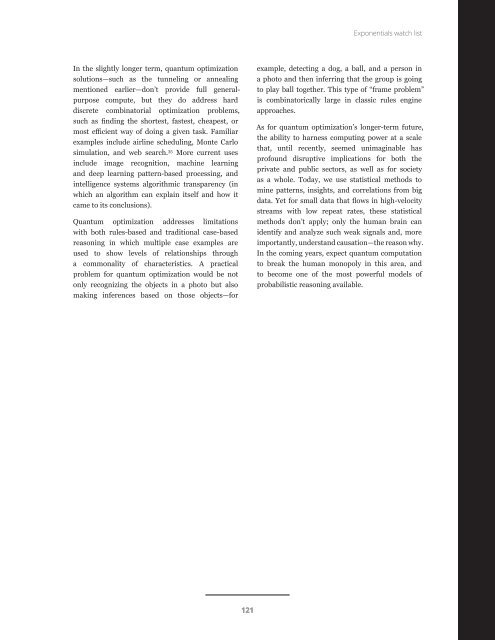Trending the trends Eight years of research
2kcf8xh
2kcf8xh
Create successful ePaper yourself
Turn your PDF publications into a flip-book with our unique Google optimized e-Paper software.
technolog<br />
Exponentials watch list<br />
In <strong>the</strong> slightly longer term, quantum optimization<br />
solutions—such as <strong>the</strong> tunneling or annealing<br />
mentioned earlier—don’t provide full generalpurpose<br />
compute, but <strong>the</strong>y do address hard<br />
discrete combinatorial optimization problems,<br />
such as finding <strong>the</strong> shortest, fastest, cheapest, or<br />
most efficient way <strong>of</strong> doing a given task. Familiar<br />
examples include airline scheduling, Monte Carlo<br />
simulation, and web search. 35 More current uses<br />
include image recognition, machine learning<br />
and deep learning pattern-based processing, and<br />
intelligence systems algorithmic transparency (in<br />
which an algorithm can explain itself and how it<br />
came to its conclusions).<br />
Quantum optimization addresses limitations<br />
with both rules-based and traditional case-based<br />
reasoning in which multiple case examples are<br />
used to show levels <strong>of</strong> relationships through<br />
a commonality <strong>of</strong> characteristics. A practical<br />
problem for quantum optimization would be not<br />
only recognizing <strong>the</strong> objects in a photo but also<br />
making inferences based on those objects—for<br />
example, detecting a dog, a ball, and a person in<br />
a photo and <strong>the</strong>n inferring that <strong>the</strong> group is going<br />
to play ball toge<strong>the</strong>r. This type <strong>of</strong> “frame problem”<br />
is combinatorically large in classic rules engine<br />
approaches.<br />
As for quantum optimization’s longer-term future,<br />
<strong>the</strong> ability to harness computing power at a scale<br />
that, until recently, seemed unimaginable has<br />
pr<strong>of</strong>ound disruptive implications for both <strong>the</strong><br />
private and public sectors, as well as for society<br />
as a whole. Today, we use statistical methods to<br />
mine patterns, insights, and correlations from big<br />
data. Yet for small data that flows in high-velocity<br />
streams with low repeat rates, <strong>the</strong>se statistical<br />
methods don’t apply; only <strong>the</strong> human brain can<br />
identify and analyze such weak signals and, more<br />
importantly, understand causation—<strong>the</strong> reason why.<br />
In <strong>the</strong> coming <strong>years</strong>, expect quantum computation<br />
to break <strong>the</strong> human monopoly in this area, and<br />
to become one <strong>of</strong> <strong>the</strong> most powerful models <strong>of</strong><br />
probabilistic reasoning available.<br />
121


